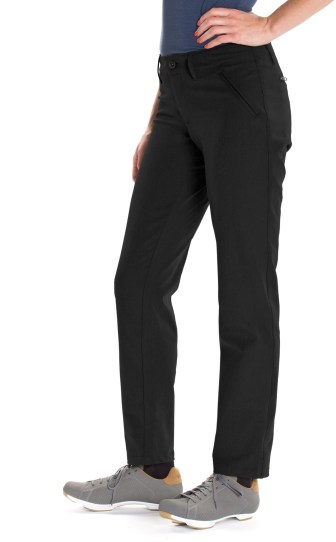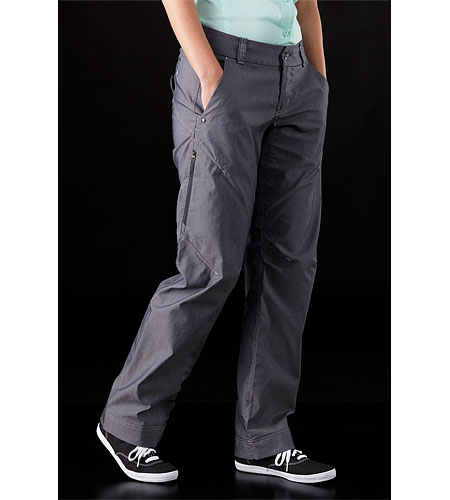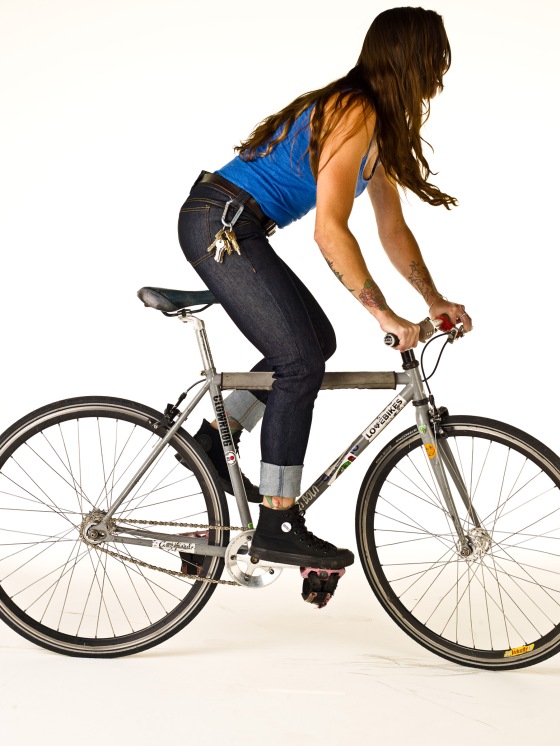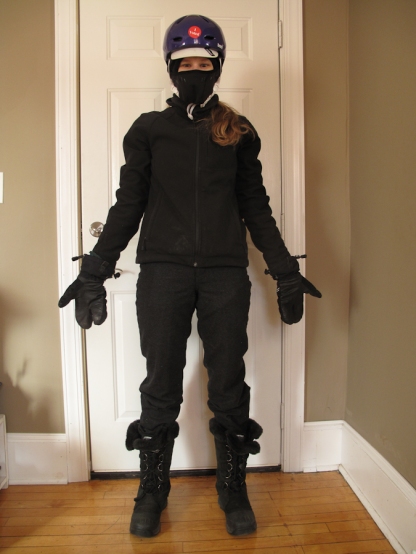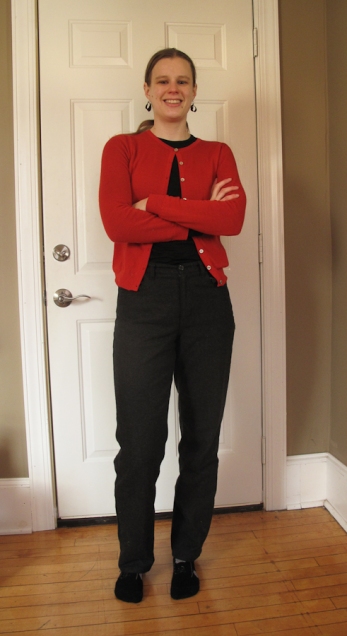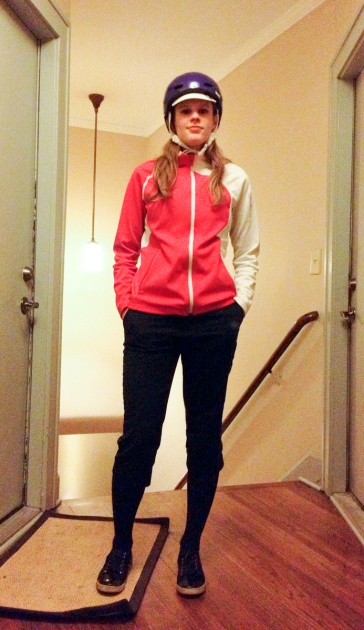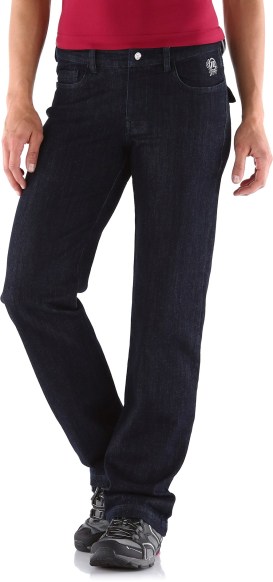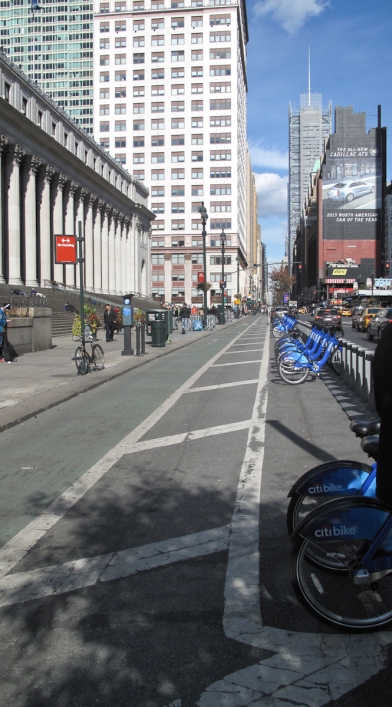
A bike share station forms part of the barrier in a Manhattan protected bike lane.
I recently got back from New York City, where I tried bike share bikes for the first time. That’s right, Minneapolis/ StPaul has had them since 2008 and I have managed to never, ever ride one. I love the idea but I have three of my own bikes and have just never gotten around to it.
Subways, buses, and hoofing it have gotten me around NYC pretty well in the past, but with the Citi Bike system finally up and running, I was eager to try out New York’s newest transit option. Most of what I thought about biking in New York City came down to three stereotypes:
1. There is always a truck, cab, etc. in the bike lane
2. Your bike will get stolen. Period.
3. Partly due to the theft threat and partly due to the fact that NYC apartments are often the same size as my Minneapolis kitchen, everyone rides folding bicycles.
I bought my Citi Bike pass and rode several times while in the city, all of them in Manhattan (stations are only located south of 62nd Street in Manhattan and west of Norstrand Avenue in Brooklyn, excluding huge stretches of the city). Here are my now slightly-more-informed stereotypes about biking in New York City, as well as my experiences using the Citi Bikes.
The City
1. Yes, there is generally a vehicle parked in the bike lane. Unless it is a protected bike lane, in which case there will be pedestrians in it. Fortunately, Citi Bikes come equipped with bells.
2. I saw plenty of fairly nice bikes locked up for hours at a time, so I assume that things do not instantly get stolen, which is what I had previously envisioned. I heard various different reports from people who actually live there. One said that it just depends on what part of the city – some are much safer than others – which I am sure is true. Another said that he assumed that his bike eventually would get stolen, but that having wheels or components stolen was a much bigger problem for him.
3. There were certainly people on folding bikes out riding around, but they were still outnumbered by full size bicycles. There were quite a few people riding Citi Bikes, too. I didn’t make a formal survey, but I estimate that I saw the most full-size bikes of all kinds, followed by bike share bikes, followed by folders.
The other stereotype I had about biking in New York City was that it would be a stressful, dangerous, high traffic venture. I’m an experienced cyclist who can hold her own in heavy rush hour traffic, but I really prefer not to. I am one of those people who would rather bike a few blocks out of the way in order to ride in relative calm. I love riding in Minneapolis.
New York was not as bad as I thought it would be. Yes, the bike lanes were narrow and there were cabs relatively close to my elbows, but unlike in Minneapolis, car traffic was so bad that the cars can’t go any faster than 10 mph, either. So instead of the more room but faster cars that I am used to, my experience of riding in crowded areas of Manhattan was not any scarier than Minneapolis. A different kind of threat, but no less threatening. And like any city, even Manhattan has some quiet side street that are downright pleasant to bike on.
NYC has, as many people have pointed out, done a great job of adding bike infrastructure in the past few years. Which doesn’t mean that all the kinks have been ironed out. I generally found things to be easy enough to navigate, with the exception of a left side bike lane that, without warning, turned into sharrows. The cabs passing me up didn’t seem to be very interested in sharing the sharrows.
The Citi Bikes
When I got to the station to buy my pass, the man in front of me was having a difficult time navigating the touch screen interface in German (there are a lot of different language options). After about 5 minutes, he gave up and I stepped up to give it a try. After realizing that I had to jab hard at the screen to get it to work, I managed to operate the system and successfully insert my credit card. I found a bike that looked to be in reasonable shape, adjusted the seat, and set off.
The first thing I noticed was that these bikes handle way differently than anything I was used to riding. I had meant to give myself more time to adjust to the bike, but was running late (and even later after waiting for my turn at the touch screen). I did get used to it as I rode. The second thing I noticed was that the rear break was loose or “mushy” as a mechanic would say. That didn’t inspire a lot of confidence, but it wasn’t so bad that I felt totally unsafe.
Arriving at the destination was easier. I just rolled up, shoved the bike in the station, waited a few seconds for the green light and walked away. My second trip up, I swiped my credit card again (the system remembers that you’ve already paid) and got a new code to punch in, which didn’t work. I tried another bike, and another. Same deal. I called the help line, which was impressively answered right away. The person working told me to swipe my card again and get a new code, which I did, and that one worked. Good customer service, but annoying that I needed it in the first place. Having to get a new code each time is a strong argument for the yearly pass, which gives you a key that you can just swipe and go.
These bikes are tanks, and they are s-l-o-w. I worked up quite a sweat pedaling it about a mile. There’s a lot more resistance here than on anything I ride at home, including my mountain bike.
Another challenge was that there are a ton of apps for finding stations, but my phone is not smart and no one could give me a map of stations (free subway maps, in contrast, abound). Station finders for people without smart phones would be helpful. Maybe I wasn’t looking in the right places. I hope that the system will expand to other parts of the city. Right now it’s pretty focused on wealthier areas, and some of my favorite places in the city aren’t served by city bike.
Despite the hiccups, I will definitely use Citi Bikes the next time I am in NYC. It was nice being able to easily, quickly get to places that might require switching trains, and in the summer it would be great to be out in the sunshine and not in a stuffy subway tunnel. It was nice not having to worry about a bike being stolen, and being able to leave the bike behind and catch a train to another borough when I needed to. I hope to see bike shares expand to other cities and will look into them whenever I’m traveling without my own set of wheels.

